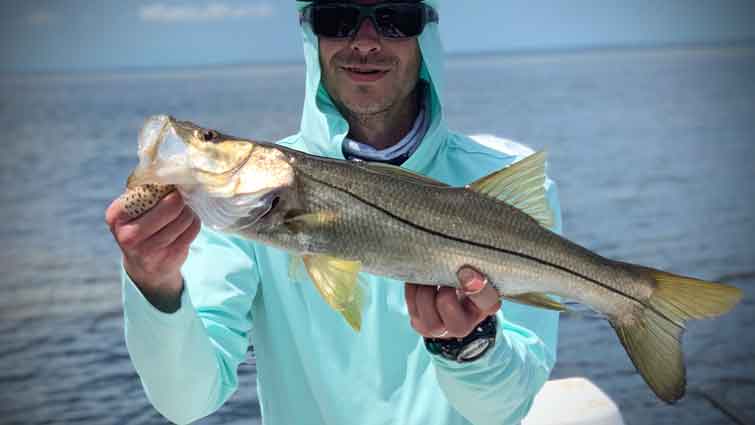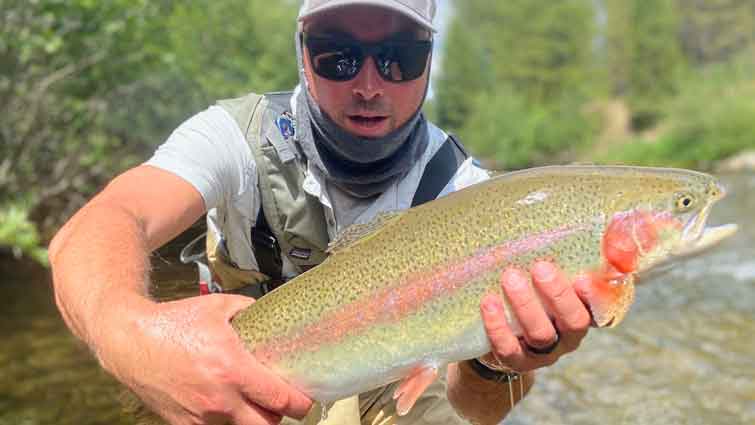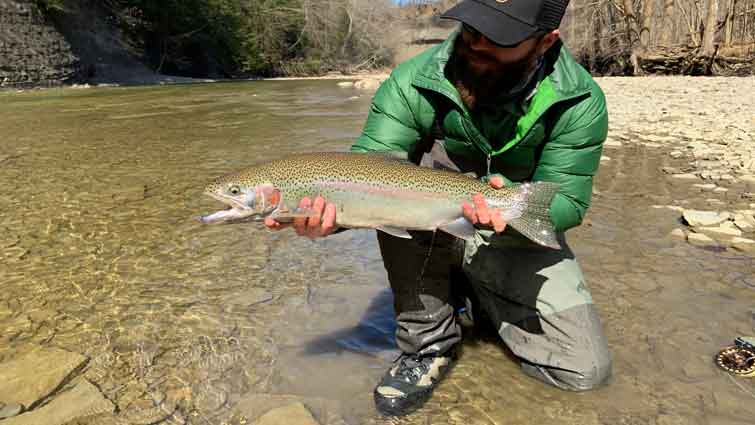Saltwater fly fishing is a challenging and exciting sport that anglers of all experience levels can enjoy. To get started in saltwater fly fishing, you will need some basic fly fishing equipment.
As a general rule the gear that you will need for saltwater fly fishing is:
- A resourceful fly rod
- Quality reels
- Fly box
- Flies
- Net
- The appropriate line
- Correct tippet
- Specialized leader
- Waders for inshore fishing
All of these specialized pieces of equipment are crucial for a successful saltwater fly fishing trip. In this article, we'll explore how to choose a rod and reel for saltwater fishing and the details of various pieces of equipment.

How Do I Choose a Saltwater Fly Rod?
The versatile rod you choose is one of the most essential pieces of equipment for saltwater fly fishing. To be successful in both casting and fighting fish, your rod should be able to handle a wide range of weights and line types.
If you're fishing saltwater, a solid 8- to 10-weight fly rod will be ideal. If you want to catch permit or striped bass, a 10-weight is probably your best bet. Anything larger, such as tarpon or sharks, should be equipped with a 12wt.
These rods are generally built a bit heavier and more durable than their freshwater counterparts. This makes them less susceptible to bending or breaking when landing big fish.
When selecting a saltwater fly rod, pay close attention to the manufacturer's specifications. Each brand builds its rods slightly differently, so it's essential to know how your chosen rod casts and what line weights it can handle.

How Do I Choose a Saltwater Reel?
Just like with the fly rod, the reel you choose for saltwater fly fishing must be able to handle a wide range of weights and line types. A good quality saltwater reel will have a sealed drag system that prevents salt and moisture from damaging the gears.
To choose a saltwater reel, consider the size of the fish you hope to catch and match it with a reel that can handle the corresponding weight. For smaller fish, a reel with a weight of 3-5 is perfect. Larger fish will require a reel with a weight of 6-10 or more.
In the end, your reel and line weight should reflect the size of your rod. It's simple to pick the best reel size if you know the type of fishing line you'll be using most often. The smaller the reel you buy, the lighter the line you use. Match the reel size to your rod. If you have an 8 weight rod, purchase an 8 weight reel.
Here's an example of how line weight matters when it comes to the fish you're after. Keep in mind the line weight will correspond directly with your reel and rod size.
|
Fly Line Weight |
Fish |
|
1-3 |
Small fish and trout. |
|
4 |
Panfish/ larger trout |
|
5 |
Trout/ “all-purpose” |
|
6 |
Large Trout/ Bass |
|
7 |
Bass/ Salmon/ Steelhead |
|
8 or more |
Large saltwater salmon |
What Fly Line Do I Use for Saltwater Fly Fishing?
Fly Lines are manufactured to the AFTMA standard, a set of industry standards created by the American Fishing Tackle Manufacturers Association. This standard is meant to assist anglers in selecting the appropriate line for their rods.
For saltwater fly fishing, a ten-weight fly line should help you bag tarpon, large salmon, and other larger, strong fish. Your line weight will ultimately depend on your reel and rod size, the type of fishing you're going for, and the conditions you're fishing in.
For example, if you have a five-weight rod, you'll want a five-weight fly line, an eight-weight rod- an eight-weight fly line. The measurement for fly lines is based on the weight of a 30-foot length of line. Fly lines are measured in grains (gr).
According to AFTMA standards, here are the various line weights and their grain measurements:
|
Line Weight |
Grain |
|
1 |
60 |
|
2 |
80 |
|
3 |
100 |
|
4 |
120 |
|
5 |
140 |
|
6 |
160 |
|
7 |
185 |
|
8 |
210 |
|
9 |
240 |
|
10 |
280 |
|
11 |
330 |
|
12 |
380 |
|
13 |
450 |
How Do You Set Up a Saltwater Fly Reel?
Rigging a saltwater fly reel can be a little more complicated than rigging a freshwater reel. Your leader and tippet will also be different for saltwater fly fishing. This is because you'll be fishing for larger fish that are stronger and can break lighter tippets.
To rig a saltwater fly reel, you'll need the fly line, backing, a leader, and tippet. The fly line is attached to the reel, and the backing is threaded onto the spool. The leader is then attached to the fly line, and the tippet is attached to the leader.
You'll also need to decide what type of fly line backing you want to use. Fly line backing is the line that goes on your reel before your fly line. It's used to give your fly line more weight and length, which is especially important when fishing in windy conditions or for larger fish.
To match the right line weight with your rod, it's important to understand the concept of "forward taper." A forward-taper line is specifically designed to work with a certain weight fly rod. The greater the taper, the heavier the line weight. So, a fly line with a pronounced taper will be heavier than one with a more gradual taper.
How Do You Make a Saltwater Fly Fishing Leader?
Leaders can be purchased already made, or you can make them yourself. To make a saltwater fly fishing leader, you'll need a length of monofilament line, some wire, and a few beads. The monofilament line is the main part of the leader, while the wire and beads add strength and durability.
To make your own saltwater fly fishing leader begin with about 6 feet of 30-pound monofilament for the butt section, around three feet of 20-pound monofilament, then roughly 18 inches of 15-pound. You'll attach three feet of tippet to the end.
When making your own DIY fly fishing leader, you aim to create a seamless transfer of energy from the fly line through the leader. This will allow the tippet to turn over and deliver the fly accurately.

The butt section of the leader is usually heavier than the tippet. This helps to load the rod and gives power to the cast. The main section of the leader, which includes the tippet, should be as light as possible to avoid excessive drag on the fly. The final section of your leader, known as the tippet, is where you'll attach your fly.
When selecting fly line backing, you'll also need to consider its diameter. A thinner backing will spool more easily on your reel than a thicker one, but it might not be as strong. So, you'll need to find the right balance between strength and ease of spooling.
There are a few different types of fly line backing available on the market today, including braided Spectra fiber, monofilament nylon, and gel-spun polyethylene (GSP). Each type has its own advantages and disadvantages, so it's important to choose the one that best suits your needs.

What Is a 7 Weight Fly Rod Good for?
A 7 weight fly rod is perfect for beginners because it's strong enough to cast large flies and has enough finesse to handle smaller ones. It's also an excellent choice for experienced anglers who want one rod they can use for various fishing situations.
Size 7 fly rods are the most versatile. This weight can handle just about any trout situation, from small brook streams to large rivers. It can also be used for many saltwater applications, including striped bass.
When choosing a fly line, you'll need to consider the weight of the fly rod you're using. A good starting point is to match the fly line weight with the fly rod weight. So, if you're using a seven-weight fly rod, you'll want to use a seven-weight fly line.

What Is an 8 Weight Fly Rod Good for?
An 8-weight fly rod is good for larger fish, such as bonefish, tarpon, and permit. It can also be used for smaller saltwater species such as striped bass and bluefish.
8-weight rods are ideal for casting when it is windy and you are casting large flies like saltwater streamers. The strength of an eight weight means it can handle some bigger, stronger species or average-sized fish.
When choosing a fly line weight, you'll need to consider the size of the fish you're targeting. If you're fishing for larger saltwater fish, you'll want to use a heavier fly line weight. If you're fishing for smaller saltwater fish, you'll want to use a lighter fly line weight.

What Is a 9 Weight Fly Rod Good for?
A nine-weight fly rod is an ideal choice for bass anglers who like to fish big flies in open water in windy situations. A 9-weight fly rod is an absolute beast—it'll take care of just about any species out there.
9-weight fly rods are the most popular choice for saltwater fly fishing. They're great for casting in windy conditions and for larger fish like tarpon, permit, and bonefish.
When selecting a 9-weight fly rod, consider the species of fish you're targeting and the conditions you'll be fishing in. Heavier rods are great for casting large flies in windy conditions, but they can be harder to cast accurately in smaller streams. Lighter rods can be more forgiving when fishing in tight quarters, but they may not have the backbone to handle larger fish in challenging environments.
In general, a 9-weight fly rod is a good choice for anglers who want one rod that can do it all. It's perfect for bass, pike, salmon, steelhead, and saltwater species. So if you're looking for a versatile rod that can handle a variety of fishing situations, go with a nine-weight.

What Is a 10-Weight Fly Rod Good for?
10-weight fly rods are specifically designed for bigger fish. They have the power to handle large salmon, steelhead, and saltwater species. If you're targeting larger fish, or if you'll be fishing in windy conditions, a 10-weight rod is your best bet.
A 10-weight fly rod is ideal for targeting larger saltwater fish, such as tarpon, trophy largemouth, and other larger species. It can also be used for smaller fish in windy conditions.

What Is a 12 Weight Fly Rod Good For?
A 12-weight fly rod is an overkill for most applications. It's really only necessary if you're targeting very large fish in extremely windy conditions. For most anglers, a 9- or 10-weight rod will be more than sufficient.
A 12-weight fly rod is perfect for large saltwater fish like sharks and barracuda. It's also great for casting in very windy conditions.
For saltwater fly fishing, you'll need various gear, including a fly rod, reel, line, flies, and more. When choosing a fly rod for saltwater fly fishing, you'll need to consider a few factors, including the size of the fish you plan to catch and the conditions in which you'll be fishing. Saltwater rods are specifically designed for larger fish and can handle heavier line weights and windier conditions.
Reels are also an essential part of your saltwater fly fishing setup. You'll want to choose a reel that can handle the type of line weight you'll be using. Choosing your saltwater rod and reel is a crucial decision, so be sure to do your research and find the perfect setup for your needs.





